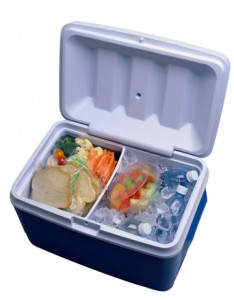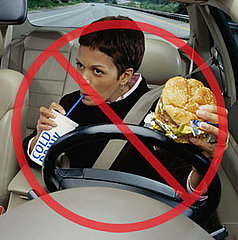So my wife, in-laws, and pets are planning on a trip across the country soon. The reason being, we’re moving from Columbus, OH to Pasadena, CA. Typically, on road trips the food choices are confined to fast-food, dine-in restaurants, and hotel food. For us, this trip will take 5 days. 5 days of fast-food and restaurant eating is definitely going to ruin one’s diet if not careful. So I put together some tips to prepare myself for this trip and decided to blog it so that others can benefit from this or comment so that I can make it better:
Breakfast
You may be eating breakfast at a restaurant, a hotel continental breakfast bar, or even the food aisle of a gas station. Always avoid excess sugar. Meals containing high carbohydrates may improve your mood for a short time, but lots of sugar can also make you groggy and sleepy. Less than desirable if you are the one doing most of the driving.
Healthy breakfast eating at a restaurant:
- Choose an omelet filled with vegetables and order a side of whole-wheat toast instead of a stack of pancakes and syrup. If you do want pancakes, try whole wheat with sugar-free syrup.
- A bowl of oatmeal with fresh fruit is very filling and good for you.
- If you want something sweet, choose a bran muffin, which is a good source of fiber. Or opt for whole-grain toast with just a little jam or jelly.
At the hotel continental breakfast bar:
- Choose a whole grain cereal with low-fat milk.
- Fresh fruit gives you vitamins and fiber.
- Yogurt or hard-boiled eggs are good sources of protein.
- Avoid sugary muffins, sweet-rolls, and pre-sweetened cereal.
- Look for single-serving whole grain breakfast cereals and low-fat milk.
- Protein bars can make a good breakfast food substitute, but watch out for extra sugar and calories (always read the labels).
- As a last resort, choose a hot breakfast sandwich or small breakfast burrito over donuts and sweet-rolls. They will have some protein, which is good for sating your hunger.
Fast food restaurants:
- Most breakfast choices have lots of calories and saturated fats, but breakfast burritos may have less than other selections.
- Fruit and yogurt parfaits will give you some calcium and protein without too much saturated fat.
- Drink low-fat milk or 100 percent juice instead of sodas and orange-flavored soft drinks.
Snacks in the Car
Eat healthy snacks in the car:
- Load up on fresh-cut vegetables and fruit. Bring along a small cooler with ice packs to keep your snacks fresh.
- Bring plenty of water. It will keep you hydrated and, if you spill it, won’t stain the upholstery like sodas.
- Individually wrapped portions of string cheese or vegetarian cheese alternatives can be kept in the cooler with the fruit and vegetables. They are a great source of calcium and protein.
- Bring baked whole grain crackers along on your trip. This is good for added fiber and nutrients.
- Don’t overindulge in greasy chips. There are baked varieties that have a lot less unhealthy fats. You need to watch how much you eat of those too, however, since they don’t offer much in the way of nutrition.
- You can also pack sandwiches made with whole grain bread and peanut butter or lean meats. Keep these in the cooler, too.
- Nuts such as almonds, cashews, and walnuts contain polyunsaturated fats and are easy to take on a trip in either individual bags or larger containers.
Healthy eating in restaurants for Lunch/Dinner:
- Order a soup or a salad to eat with your main course. Soups and salads are generally healthy and start to fill you up so that you eat less of the more calorie-dense main meal.
- Skip the entrée altogether. Soup and salad might be enough for a healthy meal.
- Split a meal with your dining partner. Most restaurants serve huge portions, so there is usually enough food to share. This saves calories and money. Besides, sharing eliminates the temptation to take leftovers back on the road, where they can’t be properly stored.
- Select foods that are prepared with healthier, low-fat methods. Baked chicken is healthy, but fried chicken has too much fat.
- Eat the vegetables. Most entrées come with at least one vegetable. If not, be sure to order a vegetable side dish.
- Skip dessert, or choose some fruit. A full meal that ends with a sugary dessert may make you feel sleepy. That might be fine if you are passenger, but a bad idea if you are the driver.
- Find sandwich shops like Subway or Quiznos that let you select your sandwich ingredients. Choose whole grain breads, lean meats, and lots of vegetables.
- Many fast food restaurants offer salads, but you need to be careful when you select one. Some of those salads are very high in fat, especially taco salads or those topped with fried chicken strips.
- Don’t super-size your meal. It sounds like a great deal, but you will eat way too much calories, fat, and sodium.
- Order sandwiches made with grilled chicken rather than fried chicken.
Eating at the hotel:
- Find a local grocery store and buy healthy snack items such as fruit, nuts, or healthy choices from a salad bar or deli section. If your hotel has a microwave, you can find healthier frozen dinners or soup.
- If your only choice for a snack is the hotel vending machine, skip the candy and chips and look for nuts or microwave popcorn.
- Some restaurants will deliver food to your hotel room and may have some healthy menu items available. If you go for a pizza delivery, don’t order extra cheese or meats high in saturated fat. Choose lots of vegetable and mushrooms. Order a side salad too.
Follow these easy tips for better nutrition on the road, and have a safe and healthy road trip.


